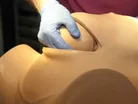Emergency caesarean simulator to help junior doctors

For the first time, junior doctors will be given the chance to practice an emergency caesarian procedure using a life-size simulator called Desperate Debra.
An emergency caesarian is often called for following the baby’s head becoming stuck in the mother’s pelvis. From this difficult position, the head is required to be pushed back into the uterus before an incision is made in the abdomen to retrieve the baby.
This highly complex and intricate procedure is often an unwelcome shock to doctors who are thrust into the situation for the first time in a real-life scenario. While the training should prepare the doctors for such an eventuality, the advantages that a real-life simulation would give trainees could be invaluable.
To read the latest edition of Healthcare Global, click here
- Celebrity fad or medical marvel
- Autism diagnoses could be possible
- Scientists invent smoking vaccination
British medical team and manufacturers, Adam,Rouilly developed Debra, realising the need for the training manikin, given that 10-20 emergency caesarians are carried out every day.
“Of all the women who reach full dilatation, somewhere between about two and five percent will end up needing this type of operation,” explained Andy Shennan, professor of obstetrics at Guy’s and St Thomas’s Hospital.
Shennan was also a pivotal figure in developing the projects and further expressed the significance of Debra:
“Because caesareans are any time day or night, it is very likely that the doctor who’s doing this is not that experienced and may not have come across a similar delivery before. So the first time you’re exposed to this problem is often in a real-life situation.
“There are other teaching models a bit like it, but certainly nothing that mimics the difficulty of getting the head out during a caesarean.”
The device, designed by Dr Graham Tydeman of NHS Fife, has received so much critical acclaim upon its unveiling that it is now thought that it will be used to further refine the procedure, as well as using it as a benchmark for future birth simulators.
“The model is really attractive in the sense that you don’t have lots of calibration and electronics and keyboards and things to go wrong, which has been an issue with other models,” asserted Gabriel Ogwo, product development manager at Adam,Rouilly.
- How is SAP Aiding NHS Procurement with BWPC?Procurement & Supply Chain
- Are AI Chatbots Making Mental Health Crises Worse?Technology & AI
- How Is the NHS Using AI to Ease Hospital Discharge Backlogs?Technology & AI
- NHS & UK Government Set Radical Course with 10-Year PlanProcurement & Supply Chain



